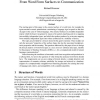1826 search results - page 280 / 366 » Using Random Forests in the Structured Language Model |
PLDI
2010
ACM
15 years 2 months ago
2010
ACM
Self-adjusting computation provides an evaluation model where computations can respond automatically to modifications to their data by using a mechanism for propagating modifica...
EJC
2009
14 years 7 months ago
2009
The starting point of this paper is the external surface of a word form, for example the agent-external acoustic perturbations constituting a language sign in speech or the dots o...
SNPD
2003
14 years 11 months ago
2003
This paper presents a new functional parallel language: Minimally Synchronous Parallel ML. The execution time can then be estimated and dead-locks and indeterminism are avoided. I...
MICCAI
2003
Springer
15 years 10 months ago
2003
Springer
We present a new brain segmentation framework which we apply to T1-weighted magnetic resonance image segmentation. The innovation of the algorithm in comparison to the state-of-the...
118
click to vote
UAI
2008
14 years 11 months ago
2008
Numerous temporal inference tasks such as fault monitoring and anomaly detection exhibit a persistence property: for example, if something breaks, it stays broken until an interve...

